Antarctica: Explorer discusses 'death star' sea creature
When you subscribe we will use the information you provide to send you these newsletters.Sometimes they’ll include recommendations for other related newsletters or services we offer.Our Privacy Notice explains more about how we use your data, and your rights.You can unsubscribe at any time.
A gigantic chunk of ice broke off from the Antarctic late in February this year, exposing an environment hidden under the ice for the last 50 years. Satellite snapshots show the iceberg (A74) measuring 490 square miles – the size of Bedfordshire county – splintering from the Brunt Ice Shelf. Researchers aboard the German Polarstern icebreaker were then able to slip into the gap between the iceberg and Antarctic to conduct their research.
Their seafloor cameras photographed a fascinating world of alien-looking molluscs, sponges and anemones.
The creatures have been thriving under a 490ft-thick (150m) cover of ice, some 18 miles (30km) below the surface.
The finds were announced last week by scientists from the Alfred Wegener Institute, Helmholtz Centre for Polar and Marine Research (AWI).
The polar researchers said in a statement: “The first images from the seafloor reveal an amazing level of biodiversity in a region that was covered by thick ice for decades.”
One of the incredible photos showcases a 10cm sea anemone attached to a rock on the seafloor.
These creatures typically feed on shrimp and small fish.
Another image shows the twisty tendrils of a brittlestar starfish raised up to catch prey.
In another picture, a pink sea worm can be seen expelling a coiling line of “faecal trail” among a scattered collection of rocks, corals and sponges.
Most of these animals are filter-feeders although it is unclear whether they feed on the remains of algae or organic particles carried on the ice.
The researchers also came across at least five species of fish and two squids.
Although thrilled at their discoveries, the researchers did not stop at just taking photos.
The scientists collected sediment samples from the seafloor, which they believe will provide more insight into the ecosystem.
In particular, the researchers are hoping to learn more about how Antarctica has been responding to climate change.
Anja Karliczek, the German Federal Research Minister, said: “It is a unique opportunity offered to researchers on board Polarstern to explore the Antarctic Ice Sheet.
“I am grateful to the crew of the Polarstern for taking on the associated hardships and also risks.
DON’T MISS…
Yellowstone ‘Armageddon’ fears: USGS probes eruption potential [INSIGHT]
Antarctica volcanoes could erupt and make planet [REPORT]
Asteroid flyby: How to watch the largest asteroid flyby of the year [LIVE]
“Polar research makes a decisive contribution to better understanding and foreseeing climate change and its consequences for our earth.
“We need this knowledge in order to be able to take effective countermeasures against climate change.
“The effects of climate change in Antarctica, among others, are worrying.”
The West Antarctic has been particularly affected by rising temperatures worldwide, with East Antarctica yet to experience global warming.
Climate models, however, suggest temperatures will start to rise in the East Antarctic this century.
According to the AWI scientists, the Antarctic is already losing ice at higher rates than before 2021.
Dr Hartmut Hellmer, a physical oceanographer and he expedition’s leader, said: “It’s extremely fortunate that we were able to respond flexibly and explore the calving event at the Brunt Ice Shelf in such detail.
“That being said, I’m even happier that we successfully replaced a number of moorings, which will continue to record elementary data on temperature, salinity, and ocean current directions and speeds once we’ve left.
“This data forms the basis for our simulations of how the ice sheet will respond to climate change.”
Icebergs the size of A74 only break off or calve every 10 years or so.
But if global warming is allowed to continue, the calving could become more frequent.
Source: Read Full Article








